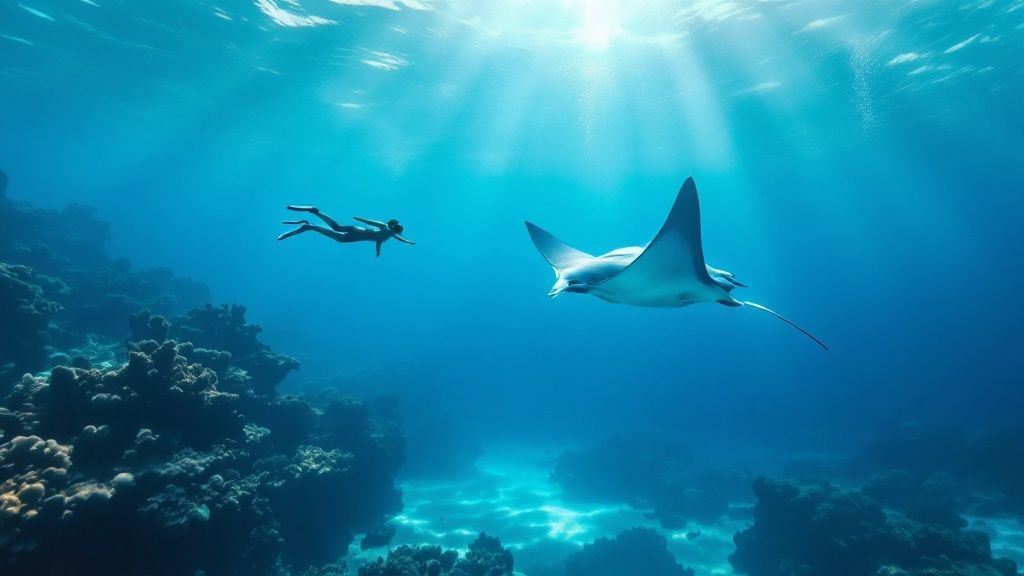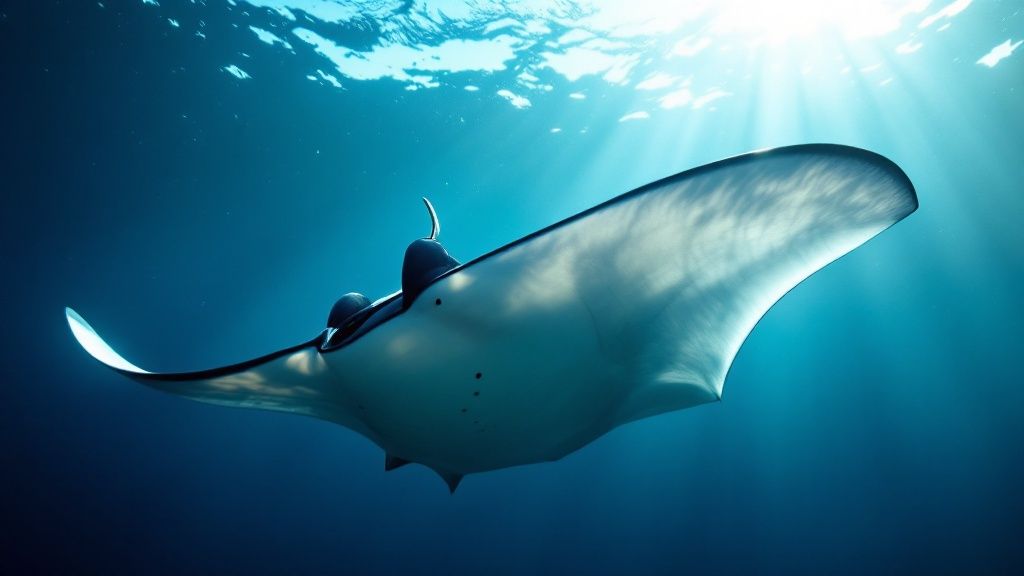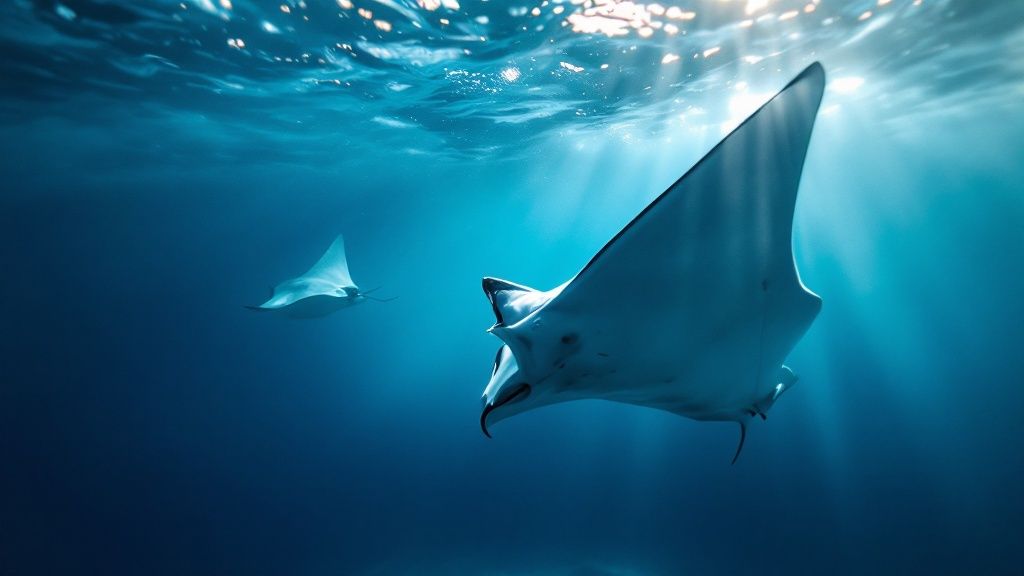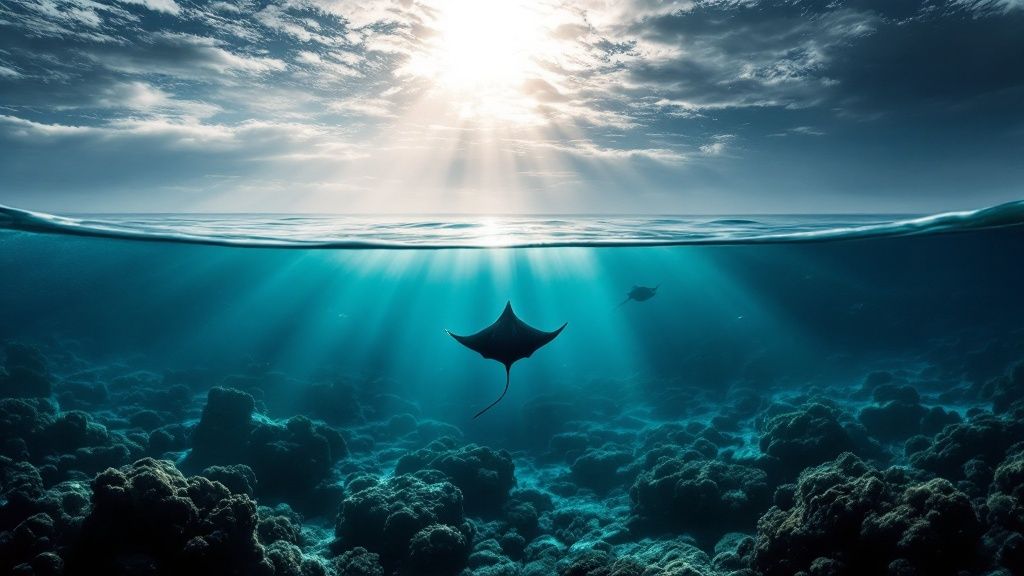The Magic of Manta Ray Encounters in Kona Waters

Kona, Hawaii, is a prime destination for an unforgettable wildlife experience: snorkeling with manta rays. These gentle giants, boasting wingspans of up to 14 feet, congregate in Kona's waters for a nightly feast, offering a captivating spectacle for lucky observers. This unique experience has solidified Kona's position as the place to be for manta ray encounters.
Kona's success stems from its distinct ecosystem and the innovative practice of night snorkeling. Tour operators strategically position artificial lights to attract plankton, the manta ray's primary food source. This creates a predictable feeding zone, attracting approximately 250 identified manta rays documented in local databases.
This translates to a remarkably high encounter rate for snorkelers, with many operators boasting an 80-90% success rate year-round. The popularity of these tours, attracting roughly 80,000 participants annually, underscores their significance as a major marine tourism activity in Hawaii. For more data on Kona manta rays, check out the Jack's Diving Locker Manta Report. Remember, preserving the ocean is vital for manta ray conservation. Learn how you can reduce water pollution and contribute to their protection.
Why Choose Kona for Manta Ray Snorkeling?
Kona provides a truly unique experience compared to other manta ray viewing spots. While some destinations offer glimpses of mantas at "cleaning stations," where they get rid of parasites, Kona offers a front-row seat to a vibrant feeding frenzy.
-
The "Dinner Bell" Effect: The lights attract plankton, creating a "dinner bell" effect that draws the manta rays in for a mesmerizing display of graceful swooping and looping through the illuminated water.
-
Up Close and Personal: Snorkelers float on the surface with their own lights, often just inches away from these gentle giants as they filter feed. This close proximity provides a truly immersive and awe-inspiring encounter. Interested in learning more? Check out the Manta Ray Night Dive of Kona with Kona Honu Divers.
-
Knowledgeable Guides: Reputable tour operators enhance the experience with insightful commentary on manta ray behavior and responsible interaction. Consider operators like Kona Honu Divers, Manta Ray Night Snorkel Hawaii, Kona Snorkel Trips, and Captain Cook's Snorkeling Tours.
The combination of predictable sightings, active feeding behavior, and expert guidance elevates the Kona manta ray snorkeling experience to something truly special. It's an adventure frequently cited as one of the most unforgettable wildlife interactions travelers have ever had.
Choosing Your Perfect Manta Ray Snorkeling Adventure

Kona is a hotspot for manta ray snorkeling. Choosing the right tour operator is your next step, and a crucial one. The right operator can make or break your experience, impacting everything from boat comfort to the guide's expertise. Doing your research and understanding each operator’s strengths is key to an unforgettable manta ray encounter.
Key Considerations for Choosing a Tour
Several factors play a vital role in picking the perfect manta ray snorkel tour. Group size, for example, can drastically affect how personal your experience feels. The tour duration influences how long you can observe these gentle giants. Let's dive into these factors and other offerings from different tour operators.
-
Group Size: Intimate experiences are often found with smaller groups. Some operators, like Kona Honu Divers, specialize in this personalized approach. Larger groups offer a more social environment, which some may prefer.
-
Tour Duration: Most tours have similar lengths, but the inclusions can vary. Some offer dinner or snacks, while others concentrate solely on the manta ray snorkel kona experience. Manta Ray Night Snorkel Hawaii and Kona Snorkel Trips offer different tour structures and durations.
-
Amenities and Features: What matters most to you? A comfortable boat? Hot beverages? Photography assistance? Or perhaps a focus on educational content? Captain Cook's Snorkeling Tours might prioritize different features than other operators, so it's essential to research.
To help you compare, we've compiled a table showcasing some of Kona's top manta ray snorkel tour operators:
Top Manta Ray Snorkel Tour Operators in Kona
Comparison of leading tour operators offering manta ray snorkeling experiences in Kona
| Tour Operator | Tour Duration | Group Size | Price Range | Amenities | Special Features |
|---|---|---|---|---|---|
| Kona Honu Divers | ~2 hours | Small (6-8) | $150-$200 | Snorkel gear, wetsuits, hot drinks | Personalized attention, focus on photography |
| Manta Ray Night Snorkel Hawaii | ~3 hours | Medium (10-15) | $120-$150 | Snorkel gear, flotation devices, snacks | Night snorkeling experience, educational briefing |
| Kona Snorkel Trips | ~2.5 hours | Medium (12-18) | $100-$140 | Snorkel gear, wetsuits | Experienced guides, focus on marine life education |
| Captain Cook's Snorkeling Tours | ~2 hours | Large (20-25) | $90-$120 | Snorkel gear, flotation devices | Budget-friendly option, social atmosphere |
Note: Prices and amenities are approximate and subject to change. Please check with individual operators for the most up-to-date information.
This table summarizes key features of various tour operators, highlighting their differences in group size, duration, and amenities. Choosing the right fit for your needs is essential for maximizing your experience.
Understanding Operator Approaches
Each operator brings a unique flavor to the manta ray snorkel kona experience. Some emphasize in-water support, offering extra guidance during the snorkel. Others prioritize pre-dive briefings to educate guests about manta ray behavior and conservation. While approaches vary, all operators share a common goal: a safe and breathtaking interaction with these majestic creatures.
Making Your Choice
By weighing these factors – group size, tour duration, amenities, and operator approach – you can narrow your options. Reading reviews and comparing offerings is essential. The ideal tour reflects your priorities. Whether you're a photography enthusiast, prefer small groups, or simply want maximum time in the water with the mantas, careful planning ensures an unforgettable Kona manta ray adventure. Make the right investment and create lasting memories.
Perfect Timing: When to Experience Manta Magic

Snorkeling with manta rays in Kona is an unforgettable experience. But choosing the right time can greatly enhance your encounter. It affects everything from how many mantas you see to how clearly you see them. While Kona offers fantastic snorkel with manta rays kona opportunities all year, understanding seasonal differences is key. For those seeking expert advice on timing, How to master timing for manta ray encounters provides further insight.
Seasonal Variations and Manta Ray Activity
Manta rays grace Kona's waters year-round, drawn by the constant presence of plankton, their main food source. However, some months offer potentially superior viewing. The calmer summer months (June-August) often see larger plankton blooms, attracting more manta rays. Data collected from 2009-2014 along the Kona Coast meticulously tracked individual manta ray sightings and movements. Though yearly totals aren't readily available, tour operators confirm noticeable seasonal trends, with peak activity correlating with the summer plankton blooms. For more on manta ray statistics, check out Manta Ray Statistics.
The Influence of Moon Phases and Water Visibility
Seasonal shifts influence plankton levels, but moon phases subtly impact visibility during night snorkeling. A new moon darkens the night sky, creating a dramatic backdrop for the tour operators’ lights. This can enhance the visibility of manta rays as they gracefully navigate the illuminated water. Water clarity also fluctuates throughout the year. Summer generally brings calmer seas and improved visibility, while winter can be more turbulent, potentially affecting your viewing experience.
The Evening Timeline: Maximizing Your Manta Ray Encounter
Tour operators strategically schedule departures to coincide with prime viewing conditions during sunset. As daylight diminishes and the ocean surface calms, the scene is set for the manta rays' arrival.
-
Check-in and Briefing: Upon arrival, you'll receive a briefing covering safety procedures, manta ray behavior, and respectful interaction guidelines. This preparation is essential for a rewarding encounter.
-
Sunset and Departure: Most tours depart around sunset to maximize your time at the viewing site during peak manta ray activity.
-
The "Dinner Bell" Effect: As darkness falls, underwater lights mimic a "dinner bell," attracting plankton and, consequently, the manta rays.
-
Observation and Return: You'll have ample time to observe the manta rays feeding and interacting before returning to shore. Several reputable operators, such as Kona Honu Divers, Manta Ray Night Snorkel Hawaii, Kona Snorkel Trips, and Captain Cook's Snorkeling Tours, have fine-tuned their schedules to capitalize on these ideal viewing times.
By understanding these timing elements and how tour operators work with nature's rhythms, you can significantly improve your snorkel with manta rays kona adventure. This allows you to truly appreciate these magnificent creatures, creating memories that will stay with you forever.
Your Night With the Mantas: What Actually Happens

From the moment you step onto the dock, the excitement for your Kona manta ray snorkel adventure truly begins. Let's walk through a typical evening, breaking down each part of this unforgettable experience.
Preparing for the Encounter
Your evening starts with check-in and getting fitted for your gear. Most operators, like Kona Honu Divers, supply wetsuits, snorkel gear, and flotation devices. You'll meet your guides and the other snorkelers, sharing in the anticipation.
A pre-snorkel briefing is next, covering essential safety procedures and guidelines for interacting respectfully with the manta rays. You'll also learn interesting facts about manta ray behavior, adding another layer of appreciation to the coming encounter.
Setting Sail for the Manta Ballet
As the sun dips below the horizon, you'll board the boat and set off for the snorkel site. Popular spots include "Manta Village" and "Manta Heaven." The boat ride itself provides stunning views of the Kona coastline at sunset.
By the time you arrive, darkness has usually fallen, adding to the mystery and excitement. Reputable operators, such as Kona Honu Divers, Manta Ray Night Snorkel Hawaii, Kona Snorkel Trips, and Captain Cook’s Snorkeling Tours, carefully select these locations for their reliable manta ray sightings.
The Underwater Spectacle
Once you reach the snorkel spot, you'll enter the water and gather around a specially equipped surfboard or floatation device with bright lights. These lights act like a "dinner bell," attracting plankton, the manta rays' primary food source.
Get ready for a mesmerizing underwater show. The manta rays arrive, often gracefully gliding and looping just inches below you.
Witnessing the Manta Ray Feast
Floating in the dark ocean while these gentle giants feed below is a truly breathtaking experience. You'll observe their unique feeding habits up close as they filter the plankton. The guides will share their knowledge, pointing out individual manta rays, often identifiable by their distinct belly markings, and explaining their behaviors. This transforms the experience into a deeper understanding of these amazing creatures.
The following table outlines a typical timeline for a manta ray night snorkel:
Manta Ray Night Snorkel Timeline
| Time | Activity | What to Expect | Tips |
|---|---|---|---|
| Late Afternoon/Early Evening | Check-in & Gear Fitting | Meet your guides and fellow snorkelers, receive wetsuits, snorkels, and flotation devices. | Arrive on time to ensure a smooth check-in process. |
| Early Evening | Pre-Snorkel Briefing | Learn about safety procedures, manta ray interaction guidelines, and fascinating facts about these creatures. | Pay close attention to the briefing, as it contains crucial information for a safe and enjoyable experience. |
| Sunset | Boat Ride to Snorkel Site | Enjoy the scenic Kona coastline as you head to "Manta Village" or "Manta Heaven." | Take in the beautiful sunset views! |
| Nightfall | Entering the Water & Snorkeling | Gather around the illuminated floatation device and watch the manta rays feed on plankton. | Stay close to the group and follow your guide's instructions. |
| 30-45 Minutes Later | Return to Boat | Share stories and reflect on the incredible experience. | Bring a waterproof camera to capture some memories (if allowed). |
This timeline offers a general overview and might vary slightly depending on the tour operator.
Return to Shore
After approximately 30-45 minutes in the water, you'll climb back on board, filled with excitement from your close encounter. The return trip provides a perfect opportunity to share your experience and reflect on the magical encounter. Back on land, you'll carry with you lasting memories of your incredible night with the mantas.
Insider Secrets for an Extraordinary Manta Experience
Turning a memorable manta ray encounter into a truly magical one takes a bit of preparation and understanding. Think of it as planning for an amazing night out, but with giant, graceful sea creatures. From what to wear to how to position yourself, these insider tips will maximize your Kona manta ray experience. Want to learn more? Check out our guide on Why you should go on a manta ray dive in Kona.
Staying Comfortable in Nighttime Waters
Comfort is key to fully enjoying your snorkel with the manta rays. Even though Kona's waters are generally warm, nighttime brings a chill. A thicker wetsuit, or layering a thin one under a rashguard, adds extra warmth. This lets you focus on the magic of the mantas, not the temperature.
Good floating techniques are important too. Relax and let your flotation device do the work, rather than constantly treading water. This conserves energy for a longer, more enjoyable snorkel. Plus, less movement means less disturbance for the mantas.
Mastering Camera Settings for Low-Light Conditions
Capturing these gentle giants in the dark requires some camera know-how. Understanding your camera’s settings helps ensure you get the best possible photos and videos. ISO, aperture, and shutter speed are your main tools.
A higher ISO, wider aperture, and slower shutter speed allow in more light. But, they can also make images grainy or blurry. Experiment with these settings before your trip to find the right balance. A red filter can also help, correcting the blue tones of deeper water for more natural-looking results. And don't forget to secure your camera to your wrist or a float!
Addressing Seasickness Concerns
If you're prone to seasickness, a few proactive steps can help. Over-the-counter medications like Dramamine or Bonine, taken an hour or two before your tour, can work wonders. Natural alternatives like ginger candies or acupressure wristbands are also popular options.
Choosing a tour operator with a shorter boat ride, such as those leaving from Keauhou Bay for the “Manta Village” site, minimizes your time on potentially choppy water. This quicker trip gets you to the mantas faster and can ease any discomfort.
Respectful Interaction Practices
Respect for these gentle creatures is essential. Maintaining a safe distance, avoiding touching them, and refraining from chasing them are all crucial. Touching disrupts their protective mucous layer, which is vital for their health.
By following these tips and respecting these incredible animals, you'll have an extraordinary manta ray snorkeling experience in Kona. This is an adventure that will stay with you long after you leave the water, fostering a deeper appreciation for these magnificent ocean inhabitants. Operators like Kona Honu Divers, Manta Ray Night Snorkel Hawaii, Kona Snorkel Trips, and Captain Cook's Snorkeling Tours often emphasize these guidelines for a positive experience for everyone.
Beyond Tourism: The Conservation Story of Kona's Mantas
The mesmerizing manta rays you see while snorkeling in Kona are more than just a tourist attraction. They're a vital part of a remarkable conservation success story. Snorkeling with these gentle giants directly supports important research and preservation work. This shift, from potential threat to protective force, highlights the changing relationship between tourism and conservation.
Identifying and Tracking Kona's Manta Rays
Researchers have developed a groundbreaking identification system using the unique belly patterns of each manta ray. Like a human fingerprint, these patterns allow scientists to track individuals and create a database of the local population. This innovative approach has significantly improved the study of manta rays. Often, guides recognize and even name individual mantas, adding a personal touch to your experience.
This detailed monitoring helps scientists study life spans, migration patterns, and the population's overall health. Understanding these factors helps conservationists address the challenges these incredible animals face and develop effective strategies for their protection.
From Threat to Protective Force: Tourism's Evolving Role
Initially, the growing popularity of manta ray tourism caused concerns about possible negative impacts on the animals and their habitat. However, responsible tour operators, working with researchers, turned this potential threat into a positive force for conservation.
-
Early Concerns: Initial worries focused on disrupting the mantas' natural behavior and harming their fragile ecosystems.
-
Evolution of Practices: Tour operators adopted strict guidelines to encourage respectful interactions and minimize environmental impact. Many Kona tour operators now use sustainable practices and actively participate in conservation initiatives.
-
Citizen Scientists: Tourism has created a network of "citizen scientists," educating participants about manta ray conservation. Many snorkelers become passionate advocates for these majestic creatures after a close encounter.
The Environmental Pressures Faced by Kona's Mantas
Manta rays face various environmental pressures, from fishing impacts to changing ocean conditions. These filter feeders are especially vulnerable to changes in plankton, their main food source. Bycatch (accidental capture in fishing nets) is another serious threat to their survival.
Understanding these challenges is key to effective conservation. For more information, check out the Kona Honu Divers' Open Letter Regarding Manta Ray Rules. The collaboration between tourism, research, and conservation is a strong example of how we can protect these amazing animals for future generations. By joining a manta ray snorkel kona tour, you directly support these essential efforts.
Experience the Magic of Kona with Kona Honu Divers
Embark on an unforgettable underwater journey with Kona Honu Divers, Hawaii's top-rated scuba diving and snorkeling company. We specialize in extraordinary manta ray encounters, prioritizing both the thrill of the experience and the well-being of these magnificent creatures. Our small-group tours and experienced guides ensure an unforgettable and educational adventure. Book your adventure today and become a part of Kona's manta ray conservation story!
